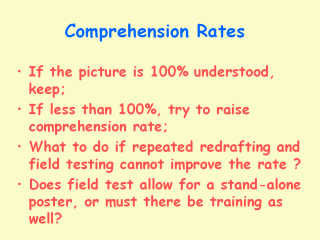| front |1 |2 |3 |4 |5 |6 |7 |8 |9 |10 |11 |12 |13 |14 |15 |16 |17 |18 |19 |review |
 |
In practice, very,
very few pictures will be 100% understood the first (or any) time. Every
community has one or two people who may be mentally challenged; or who are
visually illiterate; or simply don’t understand what it is you need from
them and thus are less than cooperative. To have a picture which is
understood clearly by 85% or more people probably is as good as one can
normally hope to achieve. It should be remembered that in most societies
where such materials are to be used, the nuclear family is the exception,
and thus the extended family is nearly always able to have one person or
more who will be able to interpret the poster for anyone not entirely clear
what is meant. If comprehension rates are less than 50% for any one picture, this is problematic. Either the picture is not fully in conformance with the cultural context in which it is to be used; or the manner of conveying information needs to be changed; or it simply is badly drawn. In Baluchestan, we had one particular problem which we were unable to overcome – how to portray that it was a pinch of common table salt. Research showed that there was no common container that families used (some used the plastic bag in which the salt was sold; some used a salt shaker; some used a wooden box; some used a saucer; and some used various ceramic bowls) – and the highest rate we were able to achieve was showing the salt in a small Chinese ceramic bowl. That rate was only 35%. Because the rate for this important picture was so low, we realised that the poster could not be used as a stand-alone item. Mothers would have to be ‘trained’ (told by Family Health Workers) to recognise each picture for what it really meant. Most would understand nearly all the pictures, but where comprehension rates were below 85% for any one picture, this discussion with a Health Worker was probably all that was needed to ensure that the whole message got across. If posters were only handed out after ‘training’ this would have the advantage that young mothers could be told that when their child was threatened by dehydration, all she would really need to know is that she must mix:
and give the mix to the child, as much and as often as it wants it. This simple message was key to the work. |